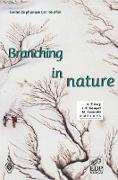- Start
- Branching in Nature
Branching in Nature
Angebote / Angebote:
Branching is probably the most common mode of growth in Nature. From plants to river networks, from lung and kidney to snow-flakes or lightning sparks, branches grow and blossom everywhere, in every realm of Nature. When Galileo Galilei stated that the geometry ofNature was written in terms ofplanes, cones and spheres, he missed one essential pattern of Nature: the tree. However, the tree has been recognized as a "scientific" objet very early, ever since the classical times. Pliny, Strabo or Theophrastus were weIl aware ofthe existence of"dendrites", i. e. , stones in the shape of plants or corals, although the existence of such stones was a puzzle to them. In his book Prodromus Cristallographiae, in which the very word cristallography appears in print for the first time (1711), Mauricius CapeIler, a Swiss naturalist, shows in between facetted crystals, several examples of dendritic crystals. He seemed already to believe in the existence of a general class of branching structures (arbusculatum in modum) in Nature. In the same spirit, his friend Jean-Jacques Scheuchzer had demonstrated experimentally that viscous fingering could generate geological dendrites (1699). At the time of Renaissance, Leornardo da Vinci was quite interested in the resemblance between trees and vessels (1508), and later, Nicola Steno did not hesitate in considering branched deposits of silver found in mines as a close relative of snow.
Folgt in ca. 5 Arbeitstagen
